Polka Dot Plant (Hypoestes Phyllostachya): Care, and Splash Plant Growing Tips
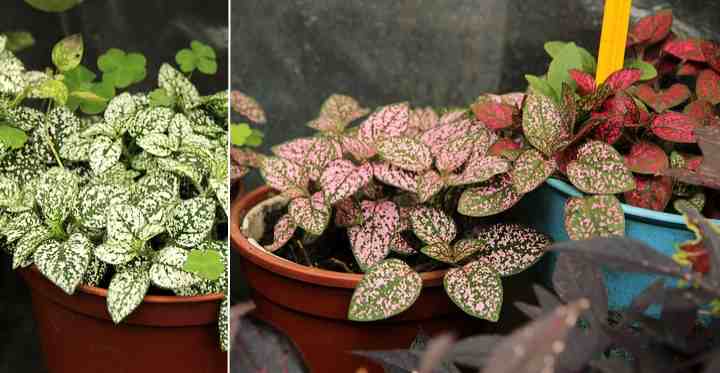
Polka dot plants are delightful flowering houseplants that have splashes of pink, white, red, or light green leaves. The polka dot patterns on the small plants’ leaves add plenty of color to any room or backyard. This houseplant is a popular type of plant because all varieties of the polka dot plant are easy to care for indoors and, in the right environment, outdoors.
The polka dot plant has the scientific name Hypoestes phyllostachya and is in the plant family Acanthaceae. Part of the Latin name means “with a leaf spike,” referring to the pointed end of the ovate-shaped leaves. There are over 100 species of polka dots, all with different shades of color and patterns.
Other common names for the polka dot plant include freckle face plant and splash plant. Some varieties of polka dot plants have descriptive names such as confetti, pink splash, and white splash. When you see pictures of variegated leaves of polka dot plants, it is easy to see how they get their name.
How to care for polka dot plant (Hypoestes Phyllostachya): Grow your polka dot plant in well-draining soil, provide adequate humidity, and bright indirect light. Polka dot plants thrive in average household temperatures between 70 and 75°F (21 – 23°C). Feed your Hypoestes Phyllostachya plant once a month in spring and summer to help the plant grow well indoors.
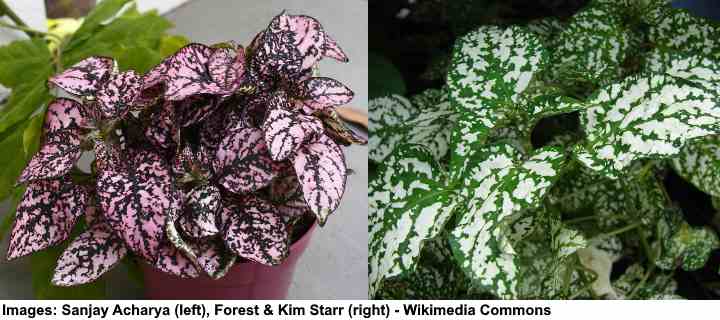
Pictures of Polka dot (Hypoestes Phyllostachya) plants
Hypoestes Plants
Native to Madagascar, South Africa, and Southeast Asia, polka dot plants are small and shrub-like. Hypoestes plants are excellent indoor plants due to their ornamental value. Pink polka dot is the most popular variety with shades of pink splashes on green leaves.
Some leaves of Hypoestes plants look like they have freckled dots. Others have colorful patterns that look like the leaves have been spray-painted. Different cultivars have red and green, white and green, or shades of green polka dots.
You can quickly grow strikingly colorful polka dot plants to brighten up your garden if you live in warm climates. The polka dot (splash) plant also grows outdoors in colder climates as an eye-catching flowering annual plant. Small pink or purple flowers also add to the beautiful colorful freckled foliage.
Read on to find out how to care for varieties of pink, red, white, or green polka dot plants. You will also learn about how to propagate these small spotted-leaf houseplants and what to do if your polka dot starts dying.
Polka Dot Plant (Pink Splash Plant)
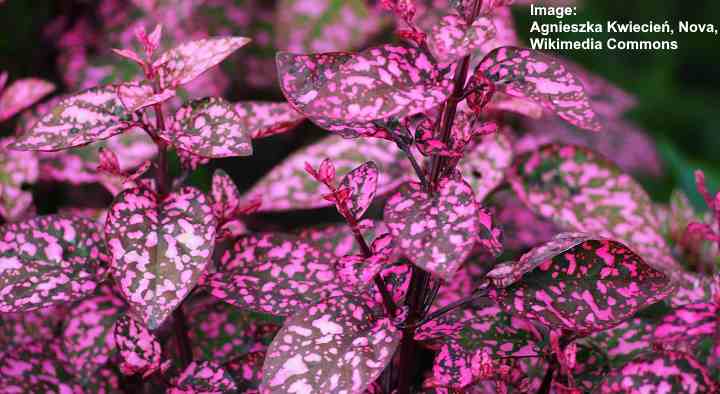
Picture of Hypoestes phyllostachya ‘Pink Splash’ cultivar
The vibrant spotted, freckled, marbled, and splash patterns on polka dot plant leaves are the main reason to grow this cute houseplant. Growing outdoors, a polka dot plant will reach heights of 3 ft. (90 cm). The colorful speckled leaves are attractive when the plant is used as a border, ground cover plant, or to add color in a large planter.
As a colorful indoor houseplant, splash plants can grow quickly and will grow to between 4” and 20” (10 – 50 cm). With a little care, your plant will continue to grow spotted leaves with pink, white, or red colors. Some varieties of polka dot plants also have freckled or marbled leaves in multiple shades.
Polka Dot Plant (Freckle Face Plant) Flowers

Polka dot plant flower
The freckle face plant doesn’t just give plenty of color with its spotted vibrant foliage, but indoor and outdoor varieties also produce flowers.
The attractive perennial flowers against spotted foliage add to the plant’s prettiness. What do polka dot plant flowers look like? The flowers are small and tubular-shaped. The tiny blossoms are usually blue, lavender, pink, or purple.
Usually, if your polka dot starts to bloom, you should pinch the flowers off. Very often, freckle face or splash plants begin to die off after flowering. Pinching some of the branches is also essential to prevent your polka dot from becoming leggy.
Polka Dot Plant Care (Hypoestes Care)

Polka dot is an easy to grow indoor plant
Although polka dot plants are on the list of easy-to-care-for houseplants, following a few care tips will help your plant thrive. Proper care for your splash plant also helps it retain its bushy shape and attractive features.
Polka dot plants are easy to grow indoors, and you can grow a plant from cuttings.
Let’s look in more detail at how to care for your Hypoestes phyllostachya plant.
Lighting Requirements for Pink Splash Plant
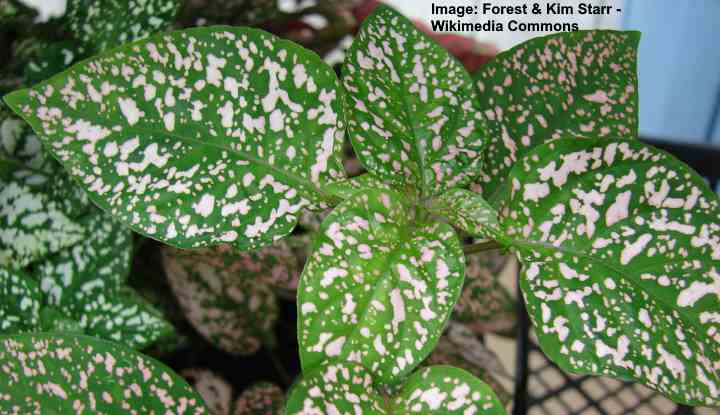
Indirect sunlight is best for polka dot plant care
Your polka dot plant needs bright sunlight to keep the vibrant pink, red, white, or green splash patterns on the leaves. Polka dot plants also grow in indirect sunlight and will keep their color. However, they need bright conditions to retain their freckled or speckled patterns.
The reason for a pink splash plant losing its color is generally due to lighting issues. If your splash plant is in a low-light or dark location, you will find that the colorful spots and marbling patters will start to fade. Also, you may find that if your splash plant is in too much direct sunlight, it will begin to lose its color.
What Soil Do Polka Dot Plants (Hypoestes) Need?
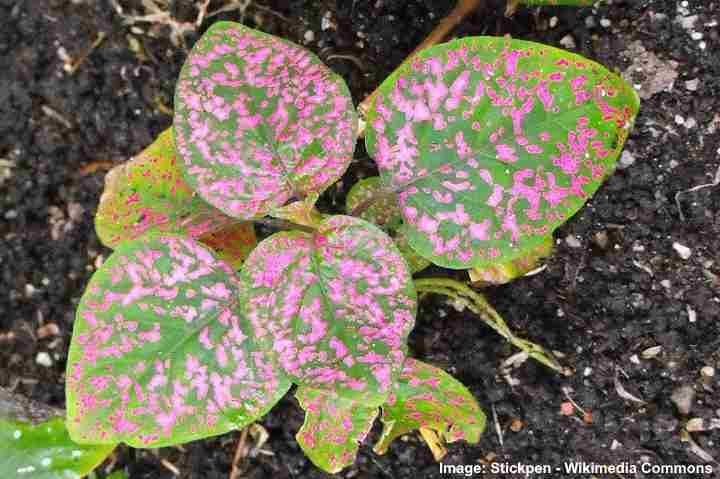
Grow polka dot plant in moist well draining soil
A polka dot plant thrives in fertile, moist soil that is well-draining. You can get healthy polka dot plants by using soil that has plenty of organic matter and has a porous mix. Having organic-rich soil also gives your freckle face plant plenty of nutrients.
If you are growing a polka dot plant from seed, you will need warm moist soil. The ideal temperature for polka dot plant seed to germinate is between 70 and 75°F (21 – 23°C).
The easiest way to grow any variety of plants from the Hypoestes genus is from cuttings. The type of soil you need for rooting polka dot cuttings is peat moss. Keep the moss moist until healthy roots appear. You can then transfer your colorful plant to suitable soil for polka dots.
How to Water Your Polka Dot (Splash Plant)
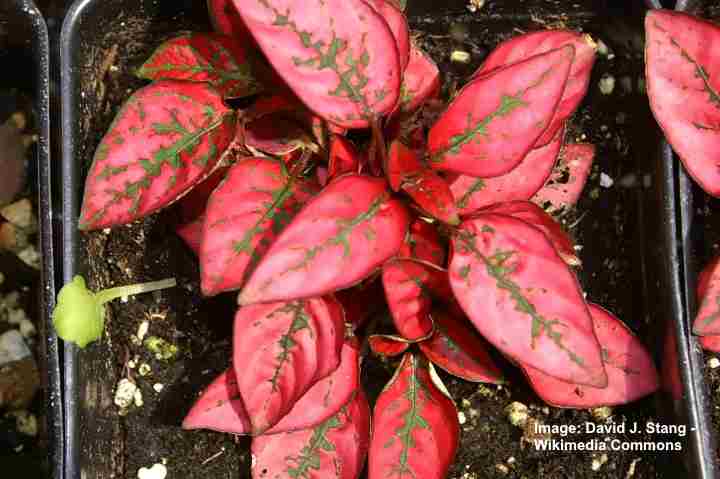
In the picture: Hypoestes phyllostachya ‘Red Splash Select’
To thrive, your polka dot plant needs just enough watering to keep the soil moist. Watering issues are usually the reason why the speckled pink or white leaves start to droop or look unhealthy.
One tip to know when to water your polka dot plant is to wait until the top part of the soil has dried out. When the top 1” (2.5 cm) is dry, that is the ideal time to water your plant. Always water the soil, not the leaves, to prevent damaging the polka-dotted leaves.
When watering this attractive indoors plant, allow the water to drain out the bottom of the pot. Not letting the splash plant sit in water helps prevent root rot due to soggy soil.
One sign that your polka dot plant requires watering is if the stems start to wilt. Usually, thorough watering will help revive your drooping polka dot plant.
Another tip when it comes to caring for a healthy polka dot plant is to water according to the pot size. Indoor splash plants usually come in small pots. These will tend to dry out quicker than large containers. So, if you have a collection of polka dot plants in different shades, regularly monitor soil moisture levels.
Feeding Your Polka Dot Plant
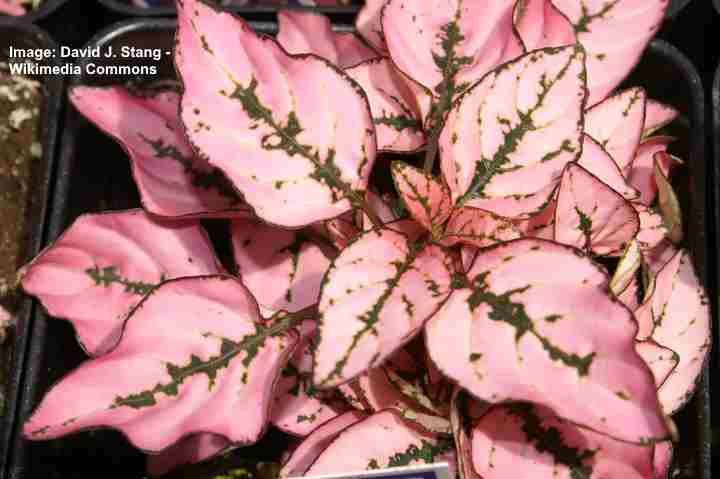
In this image: Hypoestes phyllostachya ‘Pink Splash Select’
You can encourage healthy growth if you give your polka dot plant enough fertilizer. During spring and summer, when growth is the fastest, use a liquid houseplant feed once a month. This type of fertilizer should provide all the right micronutrients your colorful houseplant needs.
During the fall and winter, you should feed your polka dot plant less. Usually, some fertilizer every other month should be enough. You should stop feeding your splash plant if it stops producing leaves in winter.
Right Growing Conditions for Your Hypoestes Phyllostachya Plant
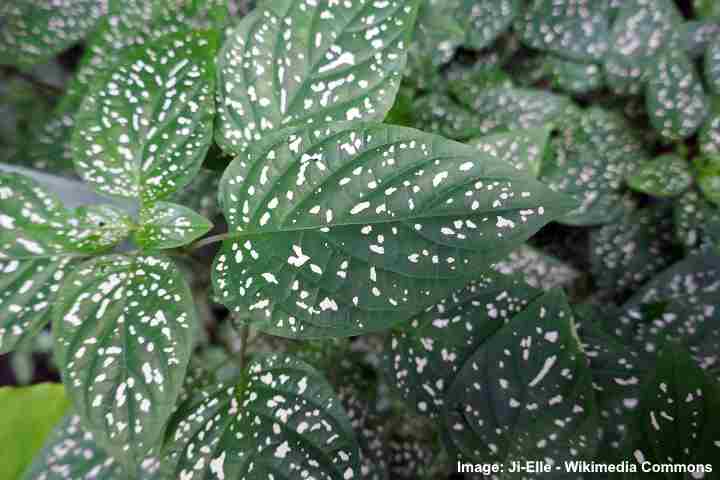
Polka Dot plants thrive in warm temperatures and high humidity
Because polka dot plants grow in tropical and subtropical climates, they are well-suited to the indoor environment. The two essential factors for caring for a polka dot plant are temperature and humidity.
The ideal temperature for a healthy, growing polka dot plant is 75°F (23 – 24°C). However, your polka dot plant should grow well indoors in temperatures as low as 60°F (16°C).
To ensure you get the perfect environment for freckle face plants, make sure there is plenty of humidity. Daily misting is the best way to get enough moisture for the leaves. This misting is especially necessary when the central heating is on or if your room has a dry atmosphere.
A warm room and humid conditions make for the perfect environment for polka dot plants to thrive.
How to Propagate and Repot a Polka Dot (Splash Plant)

You can easily propagate polka dot plants from cuttings
Polka dot plants are easy to propagate and grow from cuttings. Growing houseplants with pink and green, white and green, or red and green leaves are great gifts for any friend.
Polka dot plant propagation is best done from cuttings. Cut off a stem about 5” (13 cm) from the top. You should cut just below the stem node. Remove the lower leaves and then place the cutting in a rooting mixture such as peat moss or a glass of water.
It may take some time for roots to appear, so patience is essential. When you have roots at least 1” (2.5 cm) in length, transfer to a small pot with soil that is rich in organic matter. Water thoroughly and place your splash plant in a bright place.
Varieties of Hypoestes Phyllostachya
There is almost no end to the list of beautiful polka dot plants that have stunning multicolored foliage. Bright, vibrant specks, dots, splashes, blotches, or marbling effects create unique patterns on the green leaves.
Some of the brighter varieties of polka dot plants have white-green, light pink-green, or pale rose-green colors. The darker types of polka plants have burgundy red-green, dark red-green, or varying shades of green on the leaves.
Here are some notable Hypoestes cultivars to look out for:
- Polka dot ‘Camina’ has carmine red splashes on dark green, ovate, pointed leaves.
- ‘Pink Splash’ polka dot is one of the most popular species and has light pink dotted patterns.
- ‘Confetti Blush’ freckle face plant has olive-green pointed leaves with white veins creating intricate patterns. Other types of ‘Confetti’ polka dot plants are in red, pink, and rose shades of mottled patterns.
- Wit polka dot plants have a marbling effect of colored patterns. These can be in various shades, from white to pink to dark crimson-red.
- Pink Brocade polka dot houseplants have this name due to the unique brocade type of patterns. The most popular variety is with pink spots, but you can find these plants with colored leaves in many shades.
Polka Dot Plant Toxicity for Cats and Dogs
Polka dot plants (Hypoestes phyllostachya) are not toxic and won’t harm pets in your home.
Growing Polka Dot Plant Outdoors (Hypoestes)
Polka dot plants are the perfect type of plant if you want to grow in your yard as they have fantastic colorful foliage. Although this is a flowering plant, its flowers aren’t showy and can’t compete with the wonderfully colored leaves.
Many varieties of polka dot plants are grown as annuals outdoors. Warm summers allow polka dot plants to thrive in many countries that enjoy warm summers.
Growing in the wild, polka dots can reach up to 3 ft. (90 cm) in height. However, you will find that cultivated varieties in the garden are smaller. With regular pruning, you can have a gorgeous bushy shrub with pink, white, red, or purple spotted leaves.
Here are some tips on growing a polka dot shrub outdoors:
The best type of soil for growing polka dot plants in your garden is organic-rich soil that drains well. Make sure the plant isn’t in a location where water gathers, or you risk getting root rot.
When growing outdoors, polka dot plants thrive when the temperature is between 70 and 75°F (21 – 27°C). If you have cold winters where the temperature drops below 60°F (16°C), then it’s best to grow polka dot plants in containers or pots and bring them indoors.
Plant your polka dots in a bright location where they get sun and also partial shade.
Polka Dot Plant (Splash Plant) Is Leggy
All kinds of polka dot plants have a growth habit of becoming leggy. Although the pink-green, white-green, or red-green leaves are always attractive, the long straggling stems can give the small plant a scruffy look.
What can you do to prevent your splash plant from becoming leggy? First, make sure your plant always sits in a bright location. Getting enough light will help to keep the colored leaves vibrant and prevent legginess.
The key to avoiding your polka dot becoming leggy is to pinch back the leaves. All you have to do is pinch off a few leaves from the top of the plant when they appear. How often should you pinch off leaves? Usually, about once a week in the growing season is enough. This will help train your colorful plant to grow as a bushy shrub in a small container.
The difference between pinching and pruning is that pruning tends to involve chopping off a large number of stems or cutting a plant back. All your polka dot needs to prevent straggly stem is light pinching once a week.
How to Revive a Dying Polka Dot Plant
Although polka dot plants are easy to grow, they are sensitive to dry soil or wet soil. Usually, issues with watering are the main reason why your polka dot plant is dying.
If the soil has completely dried, water the plant thoroughly to help bring it back to life. You should water enough so that it starts to drain through holes in the bottom of the container. After that, water regularly when the top ½” to 1” (1.2 – 2.5 cm) of the soil is dry.
Allowing a polka dot plant to stand in water can also be a reason for it dying. Keep the soil moist without being saturated. This means not sitting small houseplant pots in a saucer of water.
Many houseplant enthusiasts say that blooming seems to coincide with a polka dot plant dying. So, pinch off any new flowers that appear to prevent the plant wilting and dying. Because the foliage is so colorful, the flowers don’t add to the plant’s ornamental value.
Related articles:
- Types of Jade Plants (Crassula Varieties) with Pictures
- Wandering Jew Plant (Tradescantia or Spiderwort): Care & Types
- Nerve Plant (Fittonia Plant): Caring for Vein Plants
